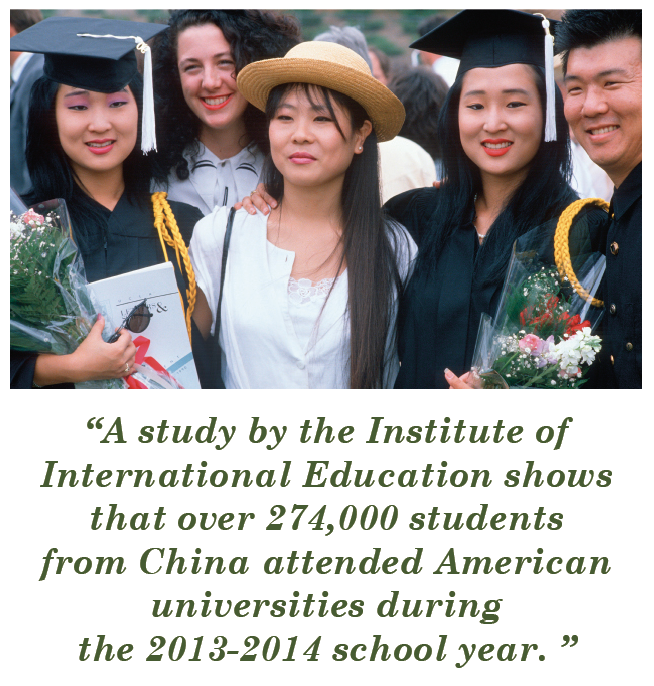Soaring granite peaks hovering over the clouds. Glittering urban skylines with taxis weaving through bustling crowds. And let’s not forget about the vibrant hillsides in warm autumnal shades of red and orange, a result of mineral deposits and oxidization. These are some of the diverse characteristics of China, the third largest country in the world with virtually every landscape imaginable throughout its provinces.
Named the world’s largest economy, China continues to grow and attracts millions of tourists each year. Although tourism has been steady in China, fewer foreigners are choosing China as their permanent home. A study conducted by UniGroup Relocation—a global relocation company helping families move for over 60 years—revealed that the amount of people moving out of China in 2014 has increased by twice as much when compared to those moving into the country.
Mass Relocation
There are a number of reasons for this. One extremely visible reason is the thick pollution that blankets many of the urban cities. Dubbed “airpocalypse” at times, air pollution in cities such as Beijing have deterred residents from venturing outside. Some primary schools have resorted to building clean air domes for students to attend classes.
But as China adopts cleaner energy sources, air quality has slowly improved. The country continues to invest heavily in renewable energy each year.
Another reason for the heavy influx of people vacating the country is due to the housing market which has consistently declined. Home prices in China have declined by almost a year’s worth of consecutive months. Although some cities did encounter an increase in prices, there was a 6.1 percent drop in 70 of China’s major cities for April 2015.
The decline in housing has hindered the country’s overall economy as many industries such as construction and steel are linked to the real estate sector. But what has caused the decline in housing?
The weakening of the real estate sector can primarily be attributed to oversupply that has affected both residential and commercial real estate. Demand simply cannot meet the glut of housing available, especially in tier three and four cities. Tier three cities include 75 million households with an income value of three trillion. Tier four cities include the same income value with the exception of households totaling 86 million.

In 2014, China reportedly had 49 million sold but vacant residential homes in urban areas. Additionally, one in five homes in the urban areas of China is vacant. This has led economists to echo what many do not want to hear: a bursting housing bubble.
However, China is enacting policies to encourage the housing sector. For example, those interested in purchasing second homes will no longer have to pay a 60 percent down payment. Instead, a 40 percent down payment is now required.
Some analysts say that recent policies have already created an upward trend in China’s housing market. Still, many investors and home buyers have flocked to other countries with more stable housing markets.
United States
The first of these countries is the United States, in which China has become the number one foreign real estate investor. According to a report from the National Association of Realtors (NAR), Chinese investors accounted for $28.6 billion of residential real estate sales in the United States during the past year.
These investors bought heavily in San Francisco, Seattle, Los Angeles, Houston, and New York. These cities exhibit vibrant cultural, culinary and tech scenes which have proven crucial to generating foreign investment.
West coast cities are attractive due to their excellent tech industries. California’s moderate climate and vivacious lifestyles are also appealing, along with its expensive market which allows for grand investments.

Similarly, New York’s elevated property prices are the strongest incentives for Chinese buyers. Here, vast amounts of capital can be sheltered, and investments can be made steadily without the deterrent of market decline.
Houston, while not a metropolis like Los Angeles or New York, is a sleeping giant that has started to awaken.
According to the U.S. Bureau of Labor Statistics, Houston is the number one job-creating city in the United States. It has a thriving oil and energy industry which is compounded with the affordability of rent and the fact that Texas has no state income tax, making it an exceedingly ideal location for recent college graduates. These attributes confirm Houston’s potential to be the next great American city, and increase its charm to international buyers.
Capital
The NAR affordability index, even though most Chinese buyers purchase in all-cash, is an important aspect to consider when understanding the impact these investments have on the American market, and the sheer buying potential these investors possess.
The index measures whether or not an average family could qualify for a mortgage loan on an average home. A figure of 100 means that a family with a median income has exactly enough money to qualify for a mortgage on a median-priced home, with figures above 100 meaning they have more than enough and figures below 100 indicating they would not qualify.
The affordability indices of San Francisco, Los Angeles, and New York vary between the 30.99 and 72.08 range. Consequently, these exceedingly luxurious markets are helpful to investors looking to protect large sums of money.
Houston and Seattle are more affordable, with affordability indices of 169.22 and 110.62, respectively. These less expensive markets mean investors can purchase a high number of properties, thereby securing their holdings and likely increasing them as property prices elevate.
Keeping in mind that these investors have the means to buy liberally in extravagant cities, it’s remarkable to consider how much their wealth could buy in more economical markets.
Workers and companies are gravitating towards these American cities at a rapid pace for their opportunity at success. This influx invigorates all sectors of the city; it creates a demand for housing and amenities, shopping centers, and entertainment outlets. The demand in turn fuels construction, stimulates the economy, and generates opportunities for real estate investors.
Australia and Canada
Australia is another preferred destination of Chinese investors. Here, they spent $8.7 billion on residential properties from 2013-2014. A Credit Suisse report released last month reports that the Chinese are expected to invest $60 billion in Australian housing over the next six years, meaning invigorated construction and real estate divisions.
Investments have been focused mostly on Sydney and Melbourne—lavish cities with elevated property prices. These costly markets provide investors the means to safeguard their wealth much more carefully than in China.
Canada is the third-favorite destination of Chinese real estate investors. The high-priced cities of Vancouver, Toronto, and Montreal are leading the way as budding markets for foreign investment in property. As with its American and Australian counterparts, these cities provide safe circumstances to diversify and protect capital.

Aside from this, Canada is the third-most alluring destination for Chinese investors because of its similarities to the U.S. The Western life, weather, and culture of Canada are all attractive to buyers.
As stated above, properties in the U.S. will continue to sell, and Chinese investors will predictably look to other areas for real estate. Other regions within the U.S. will continue to see business from foreign buyers, as will the next closest thing to the United States: Canada.
Untouched Markets
For real estate professionals in the United States, it is important to recognize the tendencies of Chinese buyers and their reasons for investing so widely and rapidly.
The first, and possibly most important motive, is the protection of wealth. The housing market in China is declining, and the wealthy are searching for secure avenues of investment. American real estate provides a sheltered method to diversify assets without having to worry about their depreciation.
Another significant reason is education. It is common practice for affluent foreigners to send their children to America for schooling, and the Chinese are no different. A study by the Institute of International Education shows that over 274,000 students from China attended American universities during the 2013-2014 school year. Many of these students come from wealthy families who are buying residences for their children studying overseas at an increasing pace.
There is also the topic of vacation homes and the prestige of being able to say you are the owner of an international property in an envious market. Many buyers are purchasing properties for enjoyment and for the status of being part of the trend of international real estate investment.
When all factors are considered, investing in American real estate is an ideal method for the diversification of wealth at this time.
Real estate competition can be ruthless, especially when selling to high-profile buyers. The idea of selling to a foreign buyer may seem far-fetched, and most agents have not experienced working with foreign clientele. This could change soon though, as Chinese buyers continue looking to America for property.
As properties continue to be taken off the market and rampant foreign investment continues, buyers will inevitably have to look to more American cities for properties.
This will significantly increase the prospect and possibility of selling to international investors for all real estate agents. For this reason, it is important to stay up-to-date with foreign investment in real estate, as international buyers may soon be entering previously untouched markets.
To view the original article please see our magazine titled “Women-owned businesses in the housing continuum” Vol 4, Issue 4 by Clicking Here

 Login
Login

